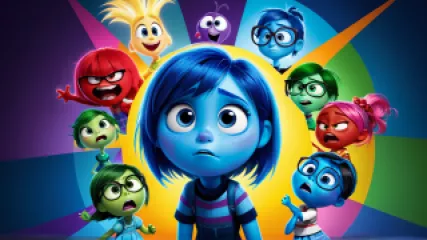Emotional Intelligence Lessons from 'Inside Out' for Children
Emotional Intelligence Lessons from 'Inside Out' for Children
As parents, educators, and those who work with children, we are always seeking new ways to help young minds develop and thrive. One unexpected source of insight can be found in the world of children's entertainment - specifically, the Pixar film "Inside Out." This 2015 animated masterpiece provides a unique window into the inner emotional lives of children, offering valuable lessons on cultivating emotional intelligence that can be applied in real-world settings.
In this article, we will explore the key emotional intelligence concepts depicted in "Inside Out" and discuss how they can be translated into practical strategies for supporting the healthy social and emotional development of children. From understanding core emotions to navigating complex feelings and relationships, the film's vivid personification of a young girl's mind presents a compelling framework for fostering emotional literacy and resilience in the next generation.
Introducing Emotional Intelligence
Emotional intelligence, or EQ, refers to the ability to recognize, understand, manage, and reason with emotions. It is a critical component of overall intelligence and plays a vital role in personal, social, and academic success. Children with strong emotional intelligence tend to exhibit better self-awareness, empathy, impulse control, and relationship skills - all of which contribute to their well-being and ability to navigate the challenges of growing up.
While traditional measures of intelligence, such as IQ, are important, research has shown that emotional intelligence may be an even stronger predictor of life outcomes. Children with high EQ are better equipped to manage stress, resolve conflicts, and form meaningful connections with others. They are also more likely to develop a growth mindset, persevere through setbacks, and maintain positive mental health.
Unfortunately, many educational systems and parenting approaches have historically emphasized cognitive development over emotional development. However, the tide is turning as the importance of emotional intelligence becomes increasingly recognized. Educators, mental health professionals, and child development experts are now exploring new ways to incorporate emotional learning into the classroom and home environment.
Emotional Literacy and the Brain
At the heart of emotional intelligence lies emotional literacy - the ability to identify, understand, and express a range of emotions. This foundational skill is essential for children to develop self-awareness, empathy, and effective communication skills.
The brain plays a crucial role in emotional literacy and overall emotional intelligence. The limbic system, which includes the amygdala and hippocampus, is responsible for processing and regulating emotions. This complex network of structures and pathways is active from birth, constantly responding to internal and external stimuli to shape our emotional experiences.
As children grow, the prefrontal cortex, the part of the brain responsible for higher-order cognitive functions, also plays a significant role in emotional intelligence. This region, which is still developing well into adolescence, is involved in decision-making, impulse control, and the ability to understand and manage emotions effectively.
By understanding the neurological underpinnings of emotional intelligence, we can develop more targeted strategies to support its development in children. This includes providing opportunities for emotional expression, teaching emotion-regulation techniques, and fostering an environment that nurtures self-awareness and empathy.
The Personification of Emotions in "Inside Out"
Pixar's "Inside Out" offers a unique and captivating exploration of emotional intelligence, using the personification of a young girl's core emotions as the central narrative device. The film follows the story of 11-year-old Riley, whose emotions - Joy, Sadness, Fear, Anger, and Disgust - are vividly brought to life as distinct characters, each with their own personalities and roles within Riley's mind.
Through this innovative approach, the film provides a tangible and accessible representation of the complex interplay between emotions, cognition, and behavior. By personifying these emotional experiences, "Inside Out" offers children and adults alike a deeper understanding of the critical role that emotions play in shaping our perceptions, decisions, and relationships.
Understanding Core Emotions
One of the key lessons from "Inside Out" is the importance of recognizing and understanding core emotions. The film's personification of Joy, Sadness, Fear, Anger, and Disgust provides a clear and relatable framework for children to identify and explore their own emotional experiences.
By introducing these distinct emotional characters, the film encourages children to acknowledge the presence and purpose of each emotion, rather than viewing them as inherently positive or negative. For example, Anger is shown to play a crucial role in standing up for oneself and advocating for one's needs, while Disgust helps to protect us from potential harm or unpleasant experiences.
This holistic view of emotions is a powerful tool for fostering emotional literacy and self-awareness in children. By understanding that each emotion serves a specific function, children can learn to accept and manage their feelings, rather than suppressing or ignoring them.
The Interplay of Emotions
Another key aspect of "Inside Out" is the way it depicts the complex interplay between different emotions. The film shows how these emotions can work together, compete, and even transform over time, mirroring the nuanced and dynamic nature of human emotional experiences.
For instance, the film explores how Sadness, initially viewed as a hindrance to Riley's happiness, ultimately plays a critical role in processing grief and facilitating personal growth. This nuanced portrayal of emotions challenges the simplistic notion of "good" and "bad" feelings, and instead encourages children to see the value and purpose in the full spectrum of their emotional experiences.
By highlighting the interconnectedness of emotions, "Inside Out" also underscores the importance of emotional regulation and the ability to navigate complex emotional states. The film's exploration of how Joy, Sadness, and the other emotions work together to shape Riley's memories and overall well-being offers valuable insights into the role of emotional intelligence in child development.
Navigating Emotional Challenges
One of the most compelling aspects of "Inside Out" is its portrayal of the emotional challenges that children face during significant life transitions, such as moving to a new city and adjusting to a new school. The film's depiction of Riley's struggle to cope with the upheaval in her life, and the subsequent disruption to the delicate balance of her emotions, resonates deeply with the experiences of many young people.
By showcasing Riley's journey through this difficult period, "Inside Out" provides a powerful framework for discussing and addressing the emotional challenges that children may encounter. The film's exploration of strategies, such as acknowledging and validating feelings, seeking social support, and finding healthy outlets for emotional expression, offers valuable insights for parents, educators, and mental health professionals working with children.
Furthermore, the film's emphasis on the importance of flexibility and adaptability in the face of change underscores the role of emotional intelligence in fostering resilience. By modeling how Riley's emotions work together to help her navigate the transition, "Inside Out" demonstrates the essential skills of emotional regulation, problem-solving, and empathy that are crucial for children's well-being and success.
Cultivating Emotional Intelligence in the Real World
With the insights and lessons gleaned from "Inside Out," we can begin to translate the film's emotional intelligence concepts into practical strategies for supporting children's social and emotional development in the real world. Here are some key ways to incorporate these lessons into the classroom, home, and broader community:
1. Emotional Literacy and Self-Awareness
Encourage children to identify and name their emotions, using the characters from "Inside Out" as a reference point. Provide opportunities for them to express their feelings through art, journaling, or open discussions. This helps to build emotional self-awareness and the language to articulate their internal experiences.
2. Emotional Regulation and Coping Strategies
Teach children practical emotional regulation techniques, such as deep breathing, mindfulness exercises, and positive self-talk, inspired by the strategies employed by the emotions in "Inside Out." Help them understand that all emotions have a purpose and can be managed effectively.
3. Empathy and Perspective-Taking
Use the characters from "Inside Out" to facilitate discussions about the importance of understanding and considering others' emotional experiences. Encourage children to put themselves in Riley's shoes and explore how the different emotions might be affecting her behavior and decision-making.
4. Navigating Transitions and Change
When children face significant life changes, such as moving to a new school or dealing with the loss of a loved one, reference the lessons from "Inside Out" to help them process their emotions. Validate their feelings, provide a supportive environment, and guide them in finding healthy coping strategies.
5. Fostering Resilience and Growth Mindset
Highlight how Riley's emotions work together to help her overcome challenges and adapt to her new circumstances. Emphasize the importance of flexibility, problem-solving, and a growth mindset in the face of adversity - qualities that are essential for emotional intelligence and long-term success.
Conclusion: Unlocking the Emotional Intelligence of Children
Pixar's "Inside Out" offers a remarkable and innovative approach to understanding and cultivating emotional intelligence in children. By personifying the core emotions and exploring their intricate interplay, the film provides a powerful framework for supporting the social and emotional development of young minds.
Through the lessons gleaned from "Inside Out," we can empower children to develop a deeper self-awareness, empathy, and ability to navigate the complex emotional landscape of growing up. By fostering emotional literacy, promoting effective coping strategies, and nurturing resilience, we can help children build the foundations for lifelong emotional intelligence and success.
As we continue to evolve our understanding of child development and the critical role of emotional intelligence, resources like "Inside Out" serve as invaluable tools for parents, educators, and mental health professionals. By harnessing the power of storytelling and the appeal of popular media, we can engage children in meaningful conversations about their emotions and equip them with the skills they need to thrive in the 21st century.
In the end, the emotional intelligence lessons from "Inside Out" remind us that the journey of growing up is not just about academic achievement or physical development, but also about the profound inner workings of the mind and heart. By empowering children to understand, express, and manage their emotions, we are not only fostering their well-being but also shaping the next generation of empathetic, resilient, and emotionally intelligent leaders.






